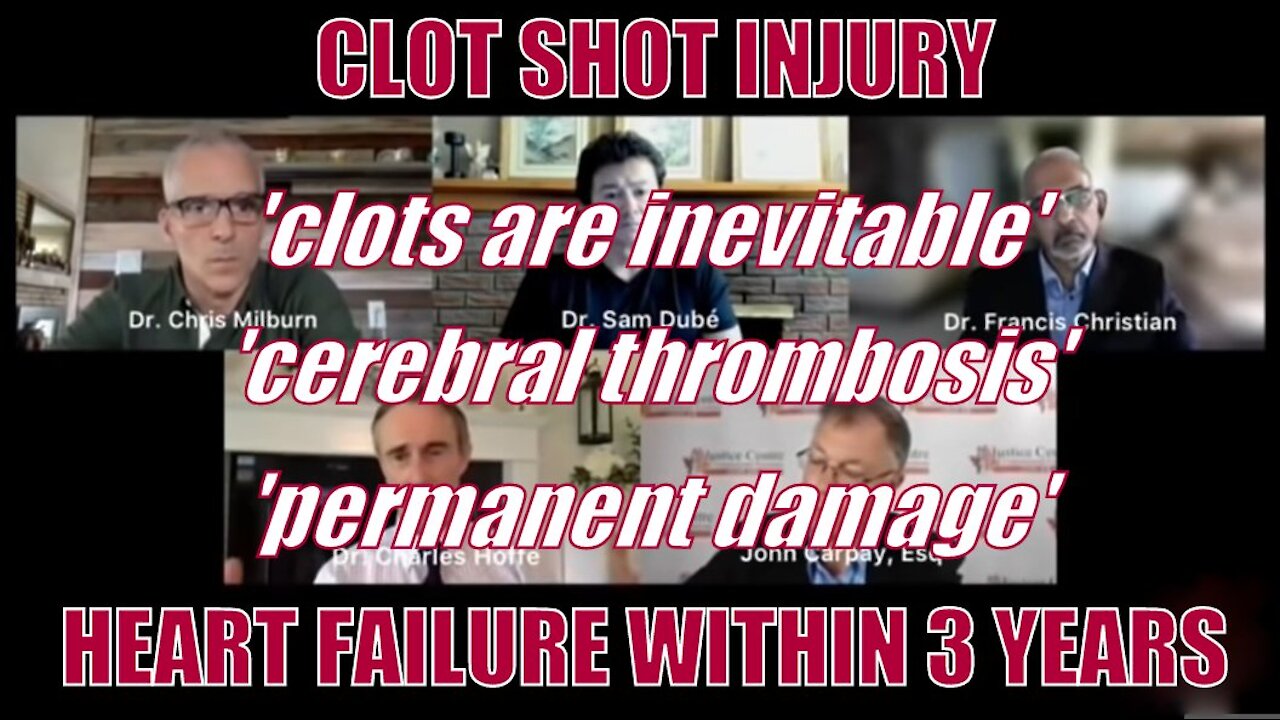Premium Only Content

CLOT SHOT INJURY
Dr Charles Hoffe
3:15 - In a virus those COVID spike proteins form part of the viral capsule. But the problem is (in the COVID shot) they're not in a virus. They're in the cells around blood vessels. So as a result they become part of the cell wall of that cell. Normally, the cells that surround your blood vessels have to be very, very smooth to enable good and unimpeded flow of blood. But as soon as you've got all these little spike proteins that become part of the cell wall it's now a rough surface. It's going to be like a very course sandpaper. (It's) what the platelets are going to interpret as a damaged vessel. It's no longer smooth, it's rough. So clotting is inevitable because the platelets that come down that vessel or going to hit a rough spot and it's (saying) 'this must be a damaged vessel. This vessel needs to be blocked to stop the bleeding'. That's how our clotting works...
Because of this and because of the nature of this clots are inevitable because of these spike proteins in the capillary networks. So I set out to then try and prove this. Could this theory be correct? And so the problem is these little clots in the capillary network are microscopic. And they are scattered so they're not going to show on any scan they just too small and too scattered. It's not like the big clots or strokes or heart attacks. So how on Earth can we know if the person clot. And the only way is with a blood test called the D-dimer. So the D-dimer is the blood test that is, that will show up a recent clot. It won't show up and and old clot. It shows up a new clot. And it doesn't tell you where the clot is. It just tells you that the clotting mechanism has been activated.
So I have now been recruiting patients from my practice; people that have come into my office and others that have heard me speak about this. And I've asked people to do this D-dimer within one week of their COVID shot. And so far, this study is on going, these are preliminary results. So far I've got 62% positive elevated D-dimer which means that the blood clots are not rare. That's what the so-called expert keep telling us. The clots are rare. The big ones are rare but the small ones are clearly happening in the majority of people; 62%.
Now I'll tell you what the real concern with this is, is that a clotted vessel is permanently damaged. That vessel never ever goes back to normal. So if this theory is correct with the really looks like by these D-dimer results; and I'm told it is being done in Australia and it is being done UK and they also found elevated D-dimers. And they, they sort of discarded the information because they said there's no clinical evidence of clots. Well the clinical... the reason is because they are microscopic and they're scattered so you're not going to see clinical evidence. But in fact all of the frequent side effects of, of, the of the shot which is headache, nausea, dizziness, fatigue, could all the signs of cerebral thrombosis on a capillary level. Those literally, you could be having thousands and thousands of tiny tiny little clots in your brain, that won't show on a scan but they will give you those exact symptoms.
So, so the concern is I have now got six people in my medical practice that that cannot exert themselves the way they used what medically we call Reduce Effort Tolerance. 6 people who now get out of breath during things that they could previously do without any problem. So I believe that these people blocked up thousands and thousands of capillaries in their lungs in these six people. So I believe these people now have permanently damaged lungs because they have got, I mean that's why they get out of breath. I have one fellow that used to walk two miles to my office every week for a shot for his arthritis and he says after a 1/4 of a mile he's done another in words his Effort Tolerance is reduced to 1/8 of what it used to be. And so I sent some of these people for chest x-rays and CT scans to see what it shows. And all it shows is is distorted architecture. What the radiologist... describes as increased reticulation it's a very non-specific thing. And it's because it's microscopic.
But the concern is because these vessels are now permanently damaged in a person's lungs when the heart tries to the heart tries to pump blood through all those damaged vessels there is increased resistance trying to pump the blood through the lungs. So those people are going to develop something called pulmonary arterial hypertension; high blood pressure in their lungs. And the concern with that is that those people will probably all develop right sided heart failure within 3 years and die because they now have increased vascular resistance through their lungs. And lung tissue and heart tissue and brain and spinal tissue and all of that does not regenerate. In other tissues it can regenerate liver and kidneys and muscle and other but they’re some tissues that cannot. And so, this absolutely explains what I've seen in my patience and that's what I'm doing to prove it in my studies ongoing.
-
 18:42
18:42
Nicholas Bowling
15 hours ago $4.52 earnedCharlie Kirk Martyred – A Christian's Response
22K27 -
 11:34
11:34
The Kevin Trudeau Show Limitless
3 days agoClassified File 4 | The Hidden Science of Brain Control REVEALED!
50.9K13 -
 2:17:41
2:17:41
Side Scrollers Podcast
23 hours agoCharlie Kirk’s Assassin in Custody + Asmongold Declares War + More | Side Scrollers
45K94 -
 33:32
33:32
ZeeeMedia
1 day agoKidnapping Cover-Up, Unvaxxed Kids Healthier, EU's New World War | Daily Pulse Ep 105
38.6K31 -
 11:04
11:04
Nate The Lawyer
3 days ago $9.77 earnedJudge, Mayor & 13 Democrats Arrested In Massive Mail-In Voter Fraud Scandal
43K45 -
 50:15
50:15
daniellesmithab
1 day agoKick-Starting Careers for Young Albertans
24.7K2 -
 39:01
39:01
Stephen Gardner
19 hours ago🔥This Will Leave You FURIOUS... What’s Really Going On?
87.6K150 -
 19:33
19:33
DeVory Darkins
21 hours ago $14.57 earnedBREAKING: Charlie Kirk's shooter in custody after making chilling confession
57.2K170 -
 2:12:43
2:12:43
TimcastIRL
14 hours agoErika Kirk Addresses Public After Charlie Kirk Assassination, Live Coverage | Timcast IRL
455K462 -
 30:59
30:59
The Charlie Kirk Show
14 hours agoCharlie Kirk's beloved wife, Mrs. Erika Kirk addresses the Nation.
598K1.81K